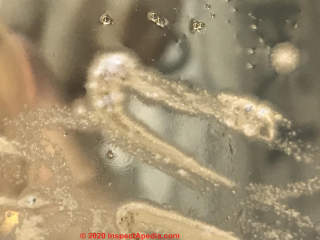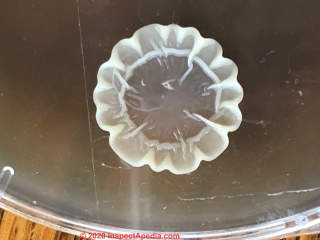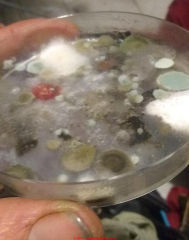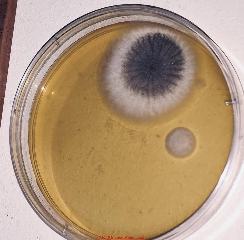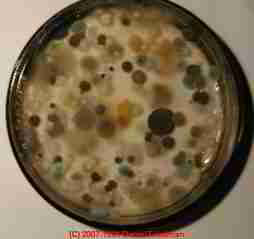 Mold Culture Identification Photographs
Mold Culture Identification Photographs
Mold Growing on Petri Dishes or Mold Culture Plates or Settlement Plates
- POST a QUESTION or COMMENT about using culture tests for building mold contamination
Photographs of mold culture test kit results:
This article illustrates common results of mold test kits that use a culture medium, and along with several companion articles listed here, it explains the availability and usefulness of eye-level or low-power magnification photographs of mold growing on mold culture plates, settlement plates, and mold test kits to try to identify indoor mold contamination.
InspectAPedia tolerates no conflicts of interest. We have no relationship with advertisers, products, or services discussed at this website.
- Daniel Friedman, Publisher/Editor/Author - See WHO ARE WE?
Mold Photos in Petri Dishes
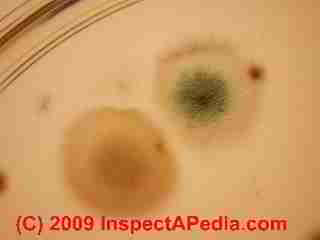 Not so Useful for Environmental Sampling and Mold Identification - What Level of Magnification is Needed to Identify Mold?
Not so Useful for Environmental Sampling and Mold Identification - What Level of Magnification is Needed to Identify Mold?
Following the list of some of our online guides to building mold just below, we include photographs of what mold looks like when growing on culture media commonly used in home test kits for mold.
In this article series we discuss the validity of nearly all of the popular mold testing methods currently in use, pointing out the strengths and weakness of each approach to mold sampling in the indoor environment, beginning with air sampling for airborne mold levels indoors.
The use, accuracy, and reliability of mold culture test kits for screening buildings for mold contamination are discussed
at MOLD CULTURE TEST KIT VALIDITY and MOLD CULTURE SAMPLING METHOD
Also see MOLD CULTURE PLATE TEST ERRORS
Mold Test Kit Culture Plates: Why Can't I Find More Photos of Mold in Petri Dishes?
Question:
I was disappointed as there were no photos at all of petri dish examples of mold, and this is the way most of us out here will be testing for mold.
So, how do I explore what mold I have in my petri dish test? I have quarter sized discs of black/dark green mold growing. I did the airborne mold test.
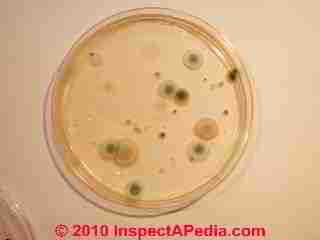 My dog is always coughing and I am in pretty good health but feel a slight "tug" in my breathing, a slight heaviness in my lungs but not bad. I rent my apartment and my landlord is a total tool.
My dog is always coughing and I am in pretty good health but feel a slight "tug" in my breathing, a slight heaviness in my lungs but not bad. I rent my apartment and my landlord is a total tool.
What can I do financially and health wise to explore my situation? Thanks for any tips! - Tony K
Reply: Microscopic Examination of Mold is Necessary for Reliable Identification
By Eye Examination of Culture Plates or Petri Dishes to Identify Mold?
The short answer is that you cannot reliably identify what mold is found in a petri dish simply by looking at some photos or color charts.
Some mold genera or species might be ruled "out" or "possible" but expert examination of the sample using high-powered microscopy (or another definitive method) is needed.
About what you can do about mold, take a look
at MOLD / ENVIRONMENTAL EXPERT, HIRE ? - for help in deciding if your situation honestly merits hiring an expert.
Then see MOLD ACTION GUIDE - WHAT TO DO ABOUT MOLD.
If you are using mold culture plates, because mold test validity and mold test accuracy are often confused,
see MOLD CULTURE SAMPLING METHOD .
Also see MOLD GROWTH on SURFACES for an index of what mold genera/species are frequently found on various building surfaces and materials.

We do have some photos of mold in petri dishes posted just above and online, at other of our online articles about the role and limitations of using mold cultures as "home test kits"
at MOLD CULTURE SAMPLING METHOD
(You'll see there that what grows in culture is not necessarily the dominant or most significant mold that is present in a building.)
Traditionally, petri dish or culture plate photos were included in early mold taxonomy texts, where color and texture of mold growth at that scale assisted in identification of cultures of a known genera down to species level.
These were photos of mold cultured in laboratories where it is sometimes possible to separate a genera of mold (Aspergillus sp.) into species or groups of species (Aspergillus niger) based on color and other macro-characteristics.
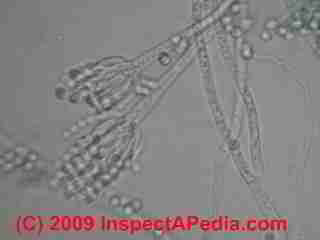
In the closeup of a mold culture petri dish growth shown in our photo at above-right, high-powered microscopic examination was necessary to identify Penicillium sp (photo at left) as one of the several mold genera growing among these green, gray,and dark gray colored mold colonies.
Sometimes we can make a pretty good guess about mold identification by the naked eye, if we see a particular color and texture of mold on a particular surface. For example this photo of mold on an orange is showing what is most likely a species of Penicillium.
But in general that "by eye" mold identification approach is not reliable.
Stereoscopic Microscope Photos of Mold to Identify It?
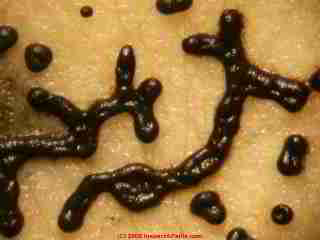
An "in-between" level of magnification, between using the naked eye to look at mold culture growing in a petri dish and using a high powered microscope is the use of a stereo microscope to magnify mold growth on surfaces such as on culture media in a petri dish.
For example, our stereoscopic microscopy photo of Fuligo septica (left) is characteristic of that particular fungus.
Stereoscopic mold photos are often beautiful (like this stereoscopic photo of Stemonitis mold growth structures taken in our lab) and may be helpful in identifying a mold genera.
Here, for contrast, is a high power microscope photo of Stemonitis mold spores.
But stereoscopic magnification is inadequate for reliable mold identification.
High Powered Microscopic Identification of Mold Spores
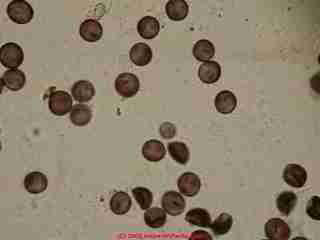
For environmental samples in which we need to identify mold genera/species or other particles, it's a different story.
As we operate a forensic lab that processes lots of materials including mold, collected by various means, we see that while petri dish photos are pretty, they are not diagnostic, nor can they be used alone for mold identification at that scale.
We need to examine mold structures and spores at 300x to 1200x to actually identify genera/species reliably.
See MOLD by MICROSCOPE for examples.
The Fuligo septica mold spores in our photo provide very different information than what we can get by eye looking at a mold culture plate or petri dish.
Also see more photos at MOLD ATLAS & PARTICLES INDEX and
our ALPHABETICAL INDEX to MOLD GENERA & SPECIES
At MOLD "TESTING" vs. MOLD "PROBLEM IDENTIFICATION"
we discuss the question of what sorts of mold testing are most useful and which are actually diagnostic, giving information about the presence of a mold problem with enough information that you know what to do about it.
Additional Comments on Mold Culture Identification
Mold cultures involve the collection of particles by air sampling pump, by gravity settlement, or by lift from a surface using a swab or tape. Some sampling equipment (Anderson™ spore traps) can collect spores directly into a petri dish of culture medium, and are used for "viable spore sampling in air."
Mold Culturing is useful for genera speciation once you have collected a single or dominant sample whose importance (frequency in the building) you already know.
As a "home test kit" for the presence of problematic mold in a building this is an unreliable method, as we describe below at "shortcomings."


Our lab photo (above left) shows two different mold colonies growing on a culture plate where individual spores settled out of the air onto this surface.
...
Reader Comments, Questions & Answers About The Article Above
Below you will find questions and answers previously posted on this page at its page bottom reader comment box.
Reader Q&A - also see RECOMMENDED ARTICLES & FAQs
On 2020-07-22 - by (mod) -
Kylie
The only useful thing that can be said about mold culture test is that they're not particularly useful in diagnosing a building mold problem. What grows in the culture may not be what's in the building. And most molds When I grow in any culture media. Your culture plate does show several different kinds of mold.
The good news is that knowing the general and species of mold in your house really would change what you need to do about it which are remove the mold, clean the surfaces, and fix the cause or leak.
On 2020-07-22 by Kylie
Any idea what this would be? I have some mold spots in my shower and bathroom and used this but I have to pay to send it out so I’m not going to do that. It’s green and fuzzy even though the mild in my shower looks quite black. Let me know what you think please!
On 2020-07-19 - by (mod) -
Sorry
Anon
I'd like to help. Your concerns are quite understandable, but no mycologist would pretend to be able to answer a toxicity question by simply looking at a culture dish.
Even within a specific mold genera and species, toxicity can vary by what material the mold is growing on. Drywall paper is not the same nutrient as agar.
Worse, we cannot assume that the molds growing on the culture accurately reflect the mold in the building.
Please take a look at the article MOLD CULTURE TEST ERRORS
On 2020-07-18 by Anonymous
I am not necessarily looking for the exact type, but the possibility of if it has more characteristics of toxic or non toxic mold.
On 2020-07-18 - by (mod) -
Sorry, the culture dish alone won't identify the mold genera/species, and may in fact be growing something else entirely - what grows on culture media is what likes the media; most moulds won't grow in any culture media.
On 2020-07-18 by Rachael Drayton
I tested a powdery mold found behind old bathroom tiles. I’m trying to tell what type of mold it is after 42+ hours in a Petri dish.
On 2020-07-16 by Helene
It started with the leak within the wall and under the wall paper. I noticed the wet wall paper and bluish circular dots size of a pennies well as a yellow stain on the ceiling connected to the wall with stains. I live in a condo on the 7th. floor with several floors above me.
I notified the guard and he called the manager who was not there because it was Sunday.
The next day, Luis the maintenance guy came and fond out that there was a hole on the roof and the rain was coming through and all the way to my floor.
He repaired the hole with some black compound. He just sprayed the wall and the ceiling and rubbed it a little bit. Well, it did not help.
Every day they promise to fix the wall properly but they always have some "emergency".
Now, the wall is covered with circular dots and dark stains.
It did not help and stones continue to spread.
On 2020-03-08 - by (mod) -
David:
we don't see any posted image.
See my note below to Irc.
On 2020-03-08 - by (mod) -
Irc
Your white flower-like growth pattern looks very much like that which would be produced if a single yeast spore landed on your culture - we're probably looking at a yeast or similar fungal fruiting body.. (Algae can produce similar structures but that's less likely).
In any event it has no diagnostic significance; if you were using a culture kit to screen your home for mold contamination you should know that only a small percent of all of the possible mold genera/species will grow in any culture at all, and what does like your culture media and grows in it may not be the important or dominant mold in the building; it's what fell onto the culture dish - maybe even from outdoors.
On 2020-03-08 by David
Pictures of setting air sampling after 2 weeks. Can anyone tell me what this is ?
E-mail me back at: dnfmcc22@aol.com
On 2019-12-04 by (mod) yeast or slime mold in culture
Irc your photo looks to me like the fruitng body of a yeast spore (a subset of molds) or less likely, a slime mold.
On 2019-12-04 by lrc
This grew in a plate that I tapped on our wall-to-wall carpet. It was next to a damp chimney (removed now), but also in a high traffic area, so it could have come from outside. Very different growth pattern than anything I've seen in other samples. This photo was taken 5 days after sampling. Can you help me identify it?
Question: shook mold off clothing onto a culture plate - Candida, possibly Candida auris?
I tapped an agar plate (MEA w/chloramphenicol) against some contaminated clothing.
It grew on the plate and on the scotch tape adhesive around the plate. (a milky look) - Photos attached.
I was wondering if you knew offhand the best lab/expert for testing this based on looks alone.(if it's even possible to know by looking)
I have a list of labs/experts you provided
at CONSULTANTS & EXPERTS DIRECTORIES - Anonymous by private email 2019/02/01
Reply: re: want the best lab/expert to examine milky substance that grew on adhesive around agar plate
Sorry, no I don't have a further recommendation besides those we exchanged by email in 2017.
It is interesting that there appears - by superficial appearance - to be one dominant growth on your culture - but of course we have no way to know if that's the dominant or important mold contamiantion on your moldy clothing.
You might want to
review MOLD CULTURE TEST KIT VALIDITY where you'll see that most molds will not grow in culture at all - so there may be other molds, including harmful ones (as well as other harmful pathogens that are not mold) that are not detected by your culture plate.
Watch out: be sure you consult promptly with your doctor about any concerns for fungal or mold-related illness (or any other illness for that matter)
I wanted to add that It is interesting that there appears - by superficial appearance - to be one dominant growth on your culture - but of course we have no way to know if that's the dominant or important mold contamiantion on your moldy clothing.
Reader follow-up:
It is is interesting. other plates tapped against clothing grew "same" white spots as well as black and others. (there are variables that could have affected this that I could explain)
(thx I have read pitfalls of agar plate testing)
This is a different apt/different mold situation as 2017.
This mold entered our apartment from a coat from online store (groupon) for my father. I've never experienced anything like this before -- it spread like wildfire onto his other shirts, coats/sweaters... in a matter of minutes. (can explain more if interested)
(Apparently there is some layperson research/anecdotal reports re a type of "highly cross-contaminating toxin." One which spreads like wildfire and other bizarre properties. I can find a good link for you, if interested)
Reply:
Sure send along whatever information you can.
In my experience molds can grow very quickly - 24-48 hours - in the right conditions. The toxicity varies enormously as does individual human sensitivity to molds.
The right response is to remove the moldy clothing and either dispose of it or try professional cleaning, and to inspect the same area for cross-contamination on nearby clothes as well as to find and fix the sources of moisture that encouraged its growth.
Reader follow-up:
2019/04/10 [Back in February] I had described my situation as quite bizarre -- a toxin entered our apartment from a Groupon coat bought online and "spread like wildfire" in a matter of minutes to other clothing, in the air.
And I'm still having trouble getting rid of it, 4 months later.
I'm now consulting with an MD in Massachusetts who helps patients (internally/immune system and externally/environment cleaning protocols) with this type of mystery "hell toxin."
My agar plate with 1 dominant growth was identified as Candida (they don't identify species). See attached [mold test lab report, copy on file- Ed.]
Editor's note: the reader's mold test lab report, from Immunolytics in Albuquerque NM, was completed on 02/04/19 and reported that a culture test on Sabouraud Dextrose Agar of sample collected fdrom a chamois shirt found Candida (yeast spores) at a level classifed as TNTC "Too Numerous To Count".
(This plate was tapped against a contaminated shirt, AFTER shirt was soaked in hydrogen/ Quaternary ammonium mixture, and air dried.)
It's interesting per recent NY Times articles -- Candida Auris is similarly described as spreading like wildfire and so difficult to eradicate, they had to spray hydrogen peroxide for 1 week (and it still grew back), they had to rip up ceilings and floors, etc.
Excerpts quoted by the reader:
Once the germ is present, it is hard to eradicate from a facility. Some hospitals have had to bring in special cleaning equipment and even rip out floor and ceiling tiles to get rid of it.
“Everything was positive — the walls, the bed, the doors, the curtains, the phones, the sink, the whiteboard, the poles, the pump,” said Dr. Scott Lorin, the hospital’s president. “The mattress, the bed rails, the canister holes, the window shades, the ceiling, everything in the room was positive.” - The New York Times
- WHAT YOU NEED TO KNOW about Candida Auris, The New York Times, retrieved 2019/04/11 original source: https://www.nytimes.com/2019/04/06/health/candida-auris-facts.html
Excerpts: Candida auris is a fungus that, when it gets into the bloodstream, can cause dangerous infections that can be life-threatening. Scientists first identified it in 2009 in a patient in Japan. In recent years, it has emerged around the world, largely in hospitals and nursing homes. There have been 587 C. auris cases reported in the United States, according to the Centers for Disease Control and Prevention, most of them in New York, New Jersey and Illinois.
C. auris is often resistant to major antifungal drugs that are typically used to treat such infections. The C.D.C. says that more than 90 percent of C. auris infections are resistant to at least one such drug, while 30 percent are resistant to two or more major drugs. Once the germ is present, it is hard to eradicate from a facility. Some hospitals have had to bring in special cleaning equipment and even rip out floor and ceiling tiles to get rid of it.
... Nearly half of patients who contract C. auris die within 90 days, according to the C.D.C. Yet the world’s experts have not nailed down where it came from in the first place.
Reply:
Anon:
If you have not done so you should consult with your doctor about any possible illness including mold-related illnesses as we agree that some of these such as C. auris can be very serious and difficult to treat.
Regarding your original do-it-yourself culture test, I mention again that because most molds will not grow in culture at all - such a test is incomplete: there may be other molds in your home including harmful ones (as well as other harmful pathogens that are not mold such as bacteria) that were not detected by your culture plate.
Watch out: We don't know from your generic culture test if your Candida (a common yeast fungus) is C. auris or something else. But from your description of its origin (shaking a sample off of clothing), it would make sense to move quickly to have a more expert consultant interview you, hear your concerns, and inspect as well as test your home for harmful mold, bacteria, or other pathogens or toxins.
Fortunately there are test labs who can speciate Candida from a properly-collected sample. Don't waste more time on unreliable test methods.
There is not much good news about Candida auris except to note that the people at greatest risk are those with compromised immune systems, to which one might intuitively add other at-risk populations such as the elderly (me), asthmatics (me), infants, and people whose other medical treatments such as for cancer result in a weakened immune system.
A summary of the most-common species of Candida does not include in the list C. auris, making that very dangerous yeast an uncommon one.
Among Candida medical problems, Candida vaginitis (CV) is the second-most common cause of vaginal infections: 85-90% of yeasts that are isolated from vaginal test swabs will be Candida albicans
- Candida albicans. 50% - opportunistic pathogenic yeast that occurs in the human gut, detected in the mouth and gastrointestinal tract of 40-60% of healthy adults - Wikipeda - or 65.3% (Pfaller et al 2010).
- Candida glabrata. 15% - 30% - commonly associated with candidiasis - or 11.3% (Pfaller et al 2010).
- Candida parapsilosis. 15% - 30% - commonly associated with candidiasis - or 6% (Pfaller et al 2010).
- Candida tropicalis. 15% - 30% - commonly associated with candidiasis - or 7.2% (Pfaller et al 2010).
- Candida krusei. ~2% - - commonly associated with candidiasis, opportunistic pathogen commonly implicated in urinary tract infections in immunocompromised patients and an uncommon cause of fungal vaginitis - or 2.4% (Pfaller et al 2010).
- Candida dubliniensis. ~1% - implicated as an agent of oral candidiasis in HIV-positive persons... also ... recovered from HIV-negative persons with clinical signs of oral candidiasis and from the genital tract of some women with vaginitis
- Candida kefyr. ~1% - classified as an emerging pathogen, previously considered rare, occasionally causing disease in immunocompromised individuals
- Candida lusitaniae. ~1% - common organism in the gastrointestinal tracts of warm-blooded animals ...found as a part of the mycoflora of the upperrespiratory, gastrointestinal and urinary tracts of hospitalized patients ... Rapidly acquired resistance to amphotericin B has been described or suspected,
- Source: cited below, retrieved 2019/04/11
- CANDIDA SP. - Candida Vaginitis [PDF] Medical Diagnostic Laboratories, LLC, Website: www.mdlabcom, Tel: 877-269-0090 retrieved 2019/04/11 original source: https://www.mdlab.com/forms/TechBulletin/Candida.pdf
- Eyre, David W., Anna E. Sheppard, Hilary Madder, Ian Moir, Ruth Moroney, T. Phuong Quan, David Griffiths et al. A Candida auris outbreak and its control in an intensive care setting [PDF] New England Journal of Medicine 379, no. 14 (2018): 1322-1331.
Excerpt from Discussion:
We report an outbreak of C. auris colonization and infection in our neurosciences ICU. The most compelling explanation for the sustained C. auris transmission that we observed was persistence of the organism on reusable equipment — in particular, on skin-surface axillary temperature probes.
Current recommended infection-control procedures for C. auris outbreaks include patient contact isolation and enhanced cleaning with chlorine-based products.8,13 In addition, we implemented “decluttering” to facilitate cleaning, reduced bedside equipment, and removed fans and forced-air convection blankets.
Despite these intensive measures, the outbreak was prolonged. - Forsberg, Kaitlin, Kate Woodworth, Maroya Walters, Elizabeth L. Berkow, Brendan Jackson, Tom Chiller, and Snigdha Vallabhaneni. "Candida auris: The recent emergence of a multidrug-resistant fungal pathogen." Medical mycology 57, no. 1 (2018): 1-12.
Abstract:
Candida auris is an emerging multidrug-resistant yeast that causes serious invasive infections with high mortality. It was first discovered in 2009, and since then, individual cases or outbreaks have been reported from over 20 countries on five continents. Controlling C. auris is challenging for several reasons:
(1) it is resistant to multiple classes of antifungals,
(2) it can be misidentified as other yeasts by commonly available identification methods, and
(3) because of its ability to colonize patients perhaps indefinitely and persist in the healthcare environment, it can spread between patients in healthcare settings.
The transmissibility and high levels of antifungal resistance that are characteristic of C. auris set it apart from most other Candida species. A robust response that involves the laboratory, clinicians, and public health agencies is needed to identify and treat infections and prevent transmission. We review the global emergence, biology, challenges with laboratory identification, drug resistance, clinical manifestations, treatment, risk factors for infection, transmission, and control of C. auris. - Pfaller MA, Moet GJ, Messer SA, Jones RN, Castanheira M. 2010d. Geographic variations in species distribution and echinocandin and azole antifungal resistance rates among Candida bloodstream infection isolates: Report from the SENTRY Antimicrobial Surveillance Program (2008 to 2009). J Clin Microbiol 49: 396–399.
- Pfaller MA, Moet GJ, Messer SA, Jones RN, Castanheira M. 2010c. Candida bloodstream infections: Comparison of species distributions and antifungal resistance patterns in community-onset and nosocomial isolates in the SENTRY Antimicrobial Surveillance Program, 2008–2009. Antimicrob Agents Chemother 55: 561–566
- Siobha´ n A. Turner, Butler, Geraldine, CANDIDA PATHOGENIC SPECIES COMPLEX, Cold Spring Harbor Perspectives in Medicine, website: wee.perspectivesinmedicine.org, retrieved 2019/04/11 original source: https://www.ncbi.nlm.nih.gov/pmc/articles/PMC4143104/pdf/cshperspectmed-HFP-a019778.pdf
...
Reader Comments, Questions & Answers About The Article Above
Below you will find questions and answers previously posted on this page at its page bottom reader comment box.
Reader Q&A - also see RECOMMENDED ARTICLES & FAQs
Question:
dharanidharendradas@gmail.com said:
I need help finding mold doctars and inspectors in Oakland Bay area.
Reply:
See MOLD DOCTORS - ENVIRONMENTAL MEDICINE
Also see MOLD CULTURE TEST KIT VALIDITY
Also see the page top EXPERTS DIRECTORY where you will find environmental inspectors.
TL I understand the appeal of the culture mold settlement plate test and indeed it's possible that some molds that it finds may be actually present in the environment where the test was performed,
but in my OPINION there's nothing accurate about using a culture test to screen a building for mold - since most molds don't grow in culture and since those that like one particular culture media may not be ones that are more serious or even dominant in the actual environment.
It's also possible that what's growing on a culture plate is simply a colony from a spore that blew in the window or door or fell off or someone's shirt.
On 2019-08-22 by T.L. And kid
That sample went from 1 day to the next, first photo I previously sent you was from today less than 70 hours from start of testing. This one I’m sending is from 18 hours before my last photo. Somehow that particular photo previously sent, I noticed condensation inside where the dark color is. Only.
Here’s the photo taken yesterday morning
On 2019-08-21 T.L. And kid
I understand these dyi tests are quite possibly inconclusive but it’s all I got to go on right now. Can’t afford to have someone come here and test. Our doctors are no use and can only test to see if we have possible mold toxicity inside our bodies with money of our own so
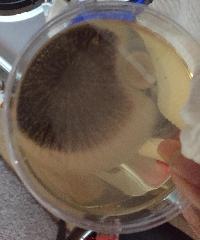 I’m pretty much on my own and extremely limited in being to test much since I’m on ssdi, and quite possibly have early signs of MS or part of that type of medical *family*
I’m pretty much on my own and extremely limited in being to test much since I’m on ssdi, and quite possibly have early signs of MS or part of that type of medical *family*
Both my child and I get sick in our apt. Everyone can see we sick, especially me. Went on vacation, family paid, came home and had to clean the heavy wet black dust that accumulated yet again in a quick span.
I feel there are visible signs of mold or something, my body is different now, I see fibers that float through the air and land on my skin.
They finally over a year later got a real plumber to check out both kitchen and bathroom sinks. Told them numerous times that water runs along the granite counters, they have to go somewhere. But after the maintenance person *fixed* both sinks after moving in, I’ve been dismissed ever since. Until now, sort of...
Apparently maintenance person put in wrong faucets, been a leak all this time hard to see due to the way place was remodeled 9 almost 10 years ago. Still over a year later I have the old refrigerator that smells like muster yet to be replaced. And I realized I am going nowhere on getting these things properly addressed and now my health has been compromised.
Although we visited family, it’s not a place we can go to live. And at this point I really need to make sure I do not have nor have inhaled toxic mold. Looking at this dish, I only see one kine growing and I’m very concerned that it’s aspergillus
Not only that, if it is, I had to clean up this stuff when we moved in our place a year and half ago. Which took 5 washing on the floor alone to stop us from having black feet. Then ever since I haven’t especially been the same
This Petri dish at the moment is all I got to go on at the price I can afford. Less than 72 hours this has been what I see
Is there even a slim slight chance this can be accurately tested? Even if you feel *no* please email me that.
Question: interpreting mold levels when I don't see the mold indoors
(June 1, 2014) John said:
I am buying a Condo and Elevated mold levels (14000 aspergillus Pennicilum vs outdoors 600) have been detected by inspectors in two air tests. 2 Inspectors found No signs of visual mold, or any water in walls (thermal imaging), nothing under sinks, etc. There was a leak in to the bath ceiling 5 years ago and it was "caught and repaired immediately". AC is new -- only 1 year old but has some mold growing in 3 places. Seller wants to clean the AC system and ducts, do 2 days of air scrubbing and then do an immediate air test to see if the problem is fixed.
I am having the Bath ceiling inspected by having holes drilled and scoped and if needed cutting 6"x6" area.
Question -- without major construction -- just AC and duct remediation and air scrubbing, do we need 24 hours after the air scrubbing -- or can the air test be done immediately? Will and immediate test pick up another source of mold (not AC) if it exists -- or do we need to ewait 24 hours after air scrub?
Reply:
John,
Not much of this sounds sensible to me.
If a severe mold problem was found and repaired five years ago you would not be detecting high levels of indoor Penicillium sp. spores today.
I suspect the problem was never found, OR there have been other leaks and there are other mold reservoirs that need to be found and removed. This case illustrates why mold "tests" alone, without a competent inspection are not so helpful. We just have to visit the investigation de novo, this time, finding where the problem resides.
Please see (and continue the discussion at )
inspectapedia.com/mold/Find-Hidden-Mold.php
on how to find hidden mold
or at
inspectapedia.com/mold/Hidden-Mold-in-Ceiling-Wall.php
on making test cuts for mold. Scoping may not be adequate.
...
Continue reading at MOLD CULTURE TEST ERRORS or select a topic from the closely-related articles below, or see the complete ARTICLE INDEX.
Or see these
Recommended Articles
- ACCURACY OF AIR TESTS for MOLD
- ENVIRONMENTAL TEST ERROR TYPES
- MOLD CULTURE SAMPLING METHOD
- MOLD CULTURE PHOTOS
- MOLD CULTURE TEST ERRORS
- MOLD CULTURE TEST KIT VALIDITY
Suggested citation for this web page
MOLD CULTURE PHOTOS at InspectApedia.com - online encyclopedia of building & environmental inspection, testing, diagnosis, repair, & problem prevention advice.
Or see this
INDEX to RELATED ARTICLES: ARTICLE INDEX to MOLD CONTAMINATION & REMEDIATION
Or use the SEARCH BOX found below to Ask a Question or Search InspectApedia
Ask a Question or Search InspectApedia
Try the search box just below, or if you prefer, post a question or comment in the Comments box below and we will respond promptly.
Search the InspectApedia website
Note: appearance of your Comment below may be delayed: if your comment contains an image, photograph, web link, or text that looks to the software as if it might be a web link, your posting will appear after it has been approved by a moderator. Apologies for the delay.
Only one image can be added per comment but you can post as many comments, and therefore images, as you like.
You will not receive a notification when a response to your question has been posted.
Please bookmark this page to make it easy for you to check back for our response.
IF above you see "Comment Form is loading comments..." then COMMENT BOX - countable.ca / bawkbox.com IS NOT WORKING.
In any case you are welcome to send an email directly to us at InspectApedia.com at editor@inspectApedia.com
We'll reply to you directly. Please help us help you by noting, in your email, the URL of the InspectApedia page where you wanted to comment.
Citations & References
In addition to any citations in the article above, a full list is available on request.
- Mark Cramer Inspection Services Mark Cramer, Tampa Florida, Mr. Cramer is a past president of ASHI, the American Society of Home Inspectors and is a Florida home inspector and home inspection educator. (727) 595-4211 mark@BestTampaInspector.com
- Thanks to Tony K for discussing mold in petri dishes and indoor sampling or mold testing using cultures - July 2010.
- In addition to citations & references found in this article, see the research citations given at the end of the related articles found at our suggested
CONTINUE READING or RECOMMENDED ARTICLES.
- Carson, Dunlop & Associates Ltd., 120 Carlton Street Suite 407, Toronto ON M5A 4K2. Tel: (416) 964-9415 1-800-268-7070 Email: info@carsondunlop.com. Alan Carson is a past president of ASHI, the American Society of Home Inspectors.
Thanks to Alan Carson and Bob Dunlop, for permission for InspectAPedia to use text excerpts from The HOME REFERENCE BOOK - the Encyclopedia of Homes and to use illustrations from The ILLUSTRATED HOME .
Carson Dunlop Associates provides extensive home inspection education and report writing material. In gratitude we provide links to tsome Carson Dunlop Associates products and services.



